Abstract
As the core power element of a centrifugal fan, the impeller’s structural parameters are important factors affecting the aerodynamic performance of the fan. Therefore, to improve the aerodynamic performance of centrifugal fans, in this study, we take the Powered Air-Purifying Respirator (PAPR) power system as the object of research and use a combination of computational fluid dynamics (CFD) and experimental validation to investigate the effects of the number of blades, blade inlet angle, blade outlet angle, blade height, and blade thickness on the aerodynamic performance of the fan. A five-factor, four-level orthogonal test table L16 (45) was selected to obtain the optimal combination of structural parameters for the impeller. In addition, in order to identify and visualize the features of the vortex, Q Criterion Normalized is applied to the simulation on the basis that the minimum pressure appears in the vortex core. In this study, Q Criterion Normalized is used to compare the internal vorticity of the prototype with that of the optimized prototype. The results show that (i) the order of influence of each parameter on the aerodynamic performance of the centrifugal fan is blade height > blade outlet angle > blade inlet angle > number of blades > blade thickness; (ii) the optimal combination of the structural parameters is number of blades 48, blade inlet angle 80°, blade outlet angle 120°, blade thickness 0.6 mm, and blade height 23 mm; the optimized prototype has an increase in air pressure of about 10%, an increase in air volume of about 31%, and an increase in efficiency from 49.61% to 53.57%; (iii) the intensity of internal vortices in the optimized prototype is weakened, the size of vortices and the number of vortices are reduced, and the homogeneity of the flow field is also improved.
1. Introduction
The primary function of a PAPR is to prevent airborne dust, particles, and pathogens from entering the respiratory tract and causing pneumoconiosis or other respiratory diseases. Therefore, it is widely used in the petrochemical, biopharmaceutical, and healthcare occupational protection fields and is an essential piece of individual respiratory protection equipment. The performance of PAPR is mainly reflected by its protection safety and comfort, and the performance of the power system is an important influence factor for both [1]. The centrifugal fan is the core component of the power system, and its performance will directly affect the performance of the PAPR power system. In addition, the impeller, as the rotating element of the fan, is an essential influence on the performance of the fan, and with the development of CFD, the use of numerical simulation to analyze the flow field of the fan saves the optimization cost of the centrifugal fan, and it is by far the most essential technological means [2]. For this reason, many scholars have used the method of numerical simulation to optimize the structure of the impeller of the centrifugal fan.
In terms of the basic structure of the impeller, i.e., the number of blades, the blade inlet angle, and the blade outlet angle, etc., Zhang [3] et al. investigated the effect of the number of blades on the aerodynamic performance and wake characteristics of a small-scale horizontal-axis wind turbine (SHAWT) by numerical simulation. The results show that as the number of blades increases, the velocity difference and turbulence intensity in the near wake region are large, the wake recovery is faster, and the unstable positions of the tip vortex and root vortex are closer to the rotor. In addition, Zhang [4] et al. also elaborated on the wake dynamics based on large-eddy simulation (LES) and optimal modal decomposition (OMD). The results show that the increase in the number of blades will promote the change of the velocity distribution of the wake from bimodal to unimodal, as well as the phenomenon that the blade tip vortex will be destabilized in advance, which will affect the energy extraction and fatigue loading of the downstream turbine. Ding [5] et al. used CFD methods to investigate the effect of different blade outlet angles on the fan. Based on the conclusions of this study, it can be seen that, under the use conditions, the vortex in the impeller channel decreases with an increase in the outlet angle. In the limiting condition, the turbulence intensity shows a tendency to reduce and then increase with an increase in outlet angle; Punnachet et al. [6] explored the effect of blade inlet and blade outlet angles on the performance of the fan. The results of this study show that when the blade inlet angle is constant and the outlet angle is increased from 30° to 40°, the efficiency of the fan increases substantially, but when the outlet angle is stable, and the inlet angle is increased from 15° to 21°, the efficiency improvement of the fan is not significant. Wu [7] et al. investigated the aerodynamic performance of fans under different blade angles of attack based on the stable three-dimensional incompressible Navier–Stokes equations and the RNG k-ε turbulence model. The results show that when the angle of attack is 8°, the vortex in the impeller is reduced, the “jet-wake” phenomenon at the impeller outlet is weakened, and the efficiency of the fan is the highest. Lei [8] et al. used CFD to analyze the cause of the impeller outlet vortex and optimize its design; Lin S. C. [9] et al. carried out a numerical simulation of the internal flow field of a small centrifugal fan and optimized the aerodynamic performance, which provided a theoretical basis for further research and design. Wei [10] et al. investigated the effect of a single circular blade profile length on the aerodynamic performance of a fan based on CFD and experimental validation.
In addition, scholars have used numerical simulations to improve the aerodynamic performance of fans by changing the spatial position of the impeller or making more significant deformations in the design of its basic structure. Zhao [11] et al., based on Ansys/Fluent, carried out a relevant study on the effect of the three-dimensional position of the semi-open impeller in the volute on the internal flow field; Kim [12] et al. improved the aerodynamic performance by changing the spatial position and shape of the impeller on the basis of CFD analysis of the fan flow field. Ottersten M. [13] et al. investigated the effect of different gap geometries on the aerodynamic characteristics of the shell-less centrifugal ventilator based on CFD. The results showed that the turbulence region can be effectively reduced by adjusting the gap geometry. Thus, the noise can be effectively reduced, and the aerodynamic performance can be improved. Prezelj [14] et al., based on numerical simulation, explored the impact of different impeller shapes on the aerodynamic performance of the fan by designing a triangular impeller channel composed of two oppositely inclined blades and studying its aerodynamic and acoustic characteristics. The experimental results of this study show that the aerodynamic characteristics of the triangular impeller channel have a small gap with the standard-design impeller channel performance but can significantly improve the impeller noise problem. Javad et al. [15] found that there is a relationship between impeller shape and fan efficiency. Based on the standard turbulence model, they compared the effects of cylindrical and conical shapes and verified them experimentally. The results show that the “jet-wake” phenomenon is lighter in the conical shape, the flow field is more uniform, and the vortex is smaller. Wang [16] et al. designed an impeller meridian shape, and with the help of numerical simulation methods, they proved that the aerodynamic performance of the fan has been improved and the velocity distribution is more reasonable. Qi [17] et al. conducted experimental and numerical studies on the noise reduction mechanism of tilted leading-edge blade diffusers for centrifugal fans, which showed that the tilted leading-edge diffuser is essential for improving the performance of the fan and reducing the noise of the fan.
In this study, the main objective is to improve the aerodynamic performance of centrifugal fans. However, at present, scholars mainly focus on the impact of changing a single factor of the impeller on the performance of centrifugal fans and less research has been conducted on the optimization of the aerodynamic performance of centrifugal fans by multiple parameters of the impeller. Therefore, this paper first uses numerical simulation to analyze the effects of the five main structural parameters of the impeller on the aerodynamic performance of the fan. These parameters include the number of blades, the blade inlet angle, the blade outlet angle, the blade height, and the blade thickness. We use the orthogonal experimental table of L16 (45) to find the best combination of impeller structural parameters and figure out the primary and secondary effects of these parameters on aerodynamic performance. More importantly, Q Criterion Normalized is used to compare the internal vorticity of the prototype with that of the optimized prototype, the main advantage of which is that minimum pressure occurs in the core of the vortex. To the best of our knowledge, Q Criterion Normalized has scarcely been applied to the flow through the centrifugal fan.
This paper is organized as follows: Section 2 describes the physical model of the impeller and the numerical method. Section 3 gives numerical results of the effect of each structural parameter of the centrifugal fan on the aerodynamic performance of the fan. Section 4 is based on orthogonal tests to obtain the optimal combination of structural parameters of the impeller and the order of influence on the aerodynamic performance. Section 5 builds an experimental platform to validate the results. Finally, the conclusions drawn from this study are summarized.
2. Physical Model and Simulation Method
2.1. Physical Model and Grid Division
This paper is based on the group’s independent research and development of a PAPR produced by the power system, which selected a brand of centrifugal fan, the impeller form for the front curved impeller, the blade shape for the single arc blade, and the main structural parameters as shown in Table 1.

Table 1.
Main structural parameters of centrifugal fans.
SolidWorks 2020 software is used to establish a three-dimensional model of the centrifugal fan. Figure 1 shows the centrifugal fan in kind and a three-dimensional modeling diagram.
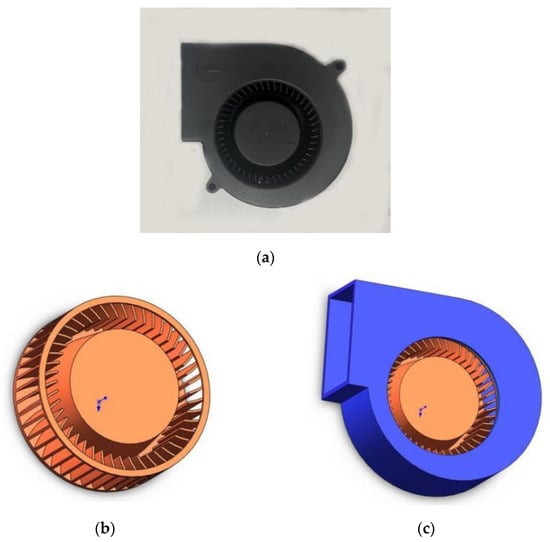
Figure 1.
Physical and modeled view of the centrifugal fan. (a) Fan material. (b) Impeller model. (c) Volute model.
2.2. Simulation Method
CFD is the process of discretizing the governing equations of a flow field and solving their discrete numerical solutions at each grid node. The fluid motion needs to satisfy three major conservation laws, i.e., the law of conservation of mass, the law of conservation of momentum, and the law of conservation of energy. The control equations are mathematical descriptions of the above three conservation laws. However, the equations of mass conservation, momentum conservation, and energy conservation are known equations, and the specific expressions can be found in the literature [18,19].
The movement of the gas inside the fan in the fluid domain is turbulent flow, which is characterized by the constant mixing of fluid particles with each other during the movement process and the randomness of the pulsation values of physical quantities such as velocity and pressure in space and time. Due to the complexity of turbulence, there has been no universal model to interpret turbulence up until now, so it is necessary to choose an appropriate turbulence model for the needs of the actual project. Three-dimensional turbulence numerical simulation methods, as shown in Figure 2, are used. Among them, the three standard methods for solving turbulence are the Reynolds time-averaged simulation method (RANS), direct numerical simulation (DNS), and large-eddy simulation (LES).
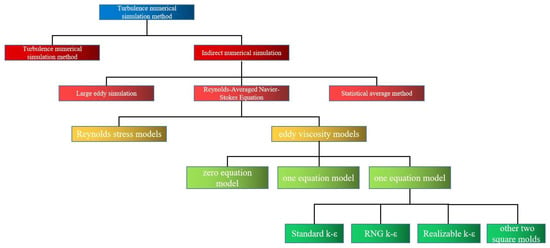
Figure 2.
Three-dimensional turbulence numerical simulation method.
The RANS method has the highest computational efficiency and can meet most of the actual engineering needs. Since RANS can be divided into k-ε and k-ω turbulence models, this paper selects the most representative k-ε turbulence model.
There are three types of k-ε turbulence models: Standard k-ε, RNG k-ε, and Realizable k-ε models. Among them, the Realizable k-ε model is widely used in various flows, including shear flow, free flow, and boundary-layer flow [20,21,22]. In addition, the Realizable k-ε model has the best performance among the two-equation turbulence models when simulating separated flows and complex secondary flows [23,24]. Therefore, considering the actual conditions of the airflow movement of the fan, the Realizable k-ε turbulence model is used for the numerical calculations in this paper.
Following the Realizable k-ε model, the transport equation for turbulent kinetic energy k and dissipation rate ε is shown as follows:
where S is the modulus of the average strain rate tensor; σk = 1.0, σε = 1.2, C2 = 1.9.
In addition, this paper has been simulated and analyzed using Ansys Fluent 2022 R1 software, and the computational settings are shown below:
- (1)
- Setting of material properties: the fluid medium is air, and its density is 1.225 kg/m3.
- (2)
- Setting of fluid domain: the impeller region is modeled by a multiple reference frame (MRF), the rotational speed is 4000 r/min, and the rest of the region is set as a static domain.
- (3)
- Grid interface setting: the interface between the impeller and the volute is set as an interface grid interface for data transfer.
- (4)
- Setting of control parameters: the SIMPLE algorithm is selected as the solution method, the second-order windward format is chosen as the discretization format, and the range of relaxation factor is 0.7~0.9.
- (5)
- Setting the iteration error: the control convergence residual is 10−5, the number of iteration steps is set to 15,000, and the performance parameters such as fan flow rate and impeller torque are monitored during the calculation process.
2.3. Grid Partitioning and Grid Independence Verification
Firstly, based on SolidWorks 3D modeling software, the non-essential structure of the centrifugal fan is simplified, and then the fluid domain is extracted to establish the simulation model. With the help of ICEM-CFD 2022 R1 meshing software, the model is meshed, the impeller is set as the rotating domain, the volute area is set as the stationary domain, and the interface surface is used between the rotating domain and the fixed domain for the transfer and interaction of data. Due to the complex structure of the centrifugal fan, the components in the fluid domain are treated with an unstructured tetrahedral mesh, which has the advantage of being more adaptable, as shown in Figure 3. In addition, the mesh is encrypted in areas such as the blade impeller channel and the dynamic and static domain interfaces. Since the quality of the mesh will have an impact on the accuracy of the numerical simulation, after the mesh delineation is completed, the smoothing tool is selected to smooth the mesh to ensure that the quality of the mesh is all greater than 0.3, which is better as far as the unstructured mesh is concerned.
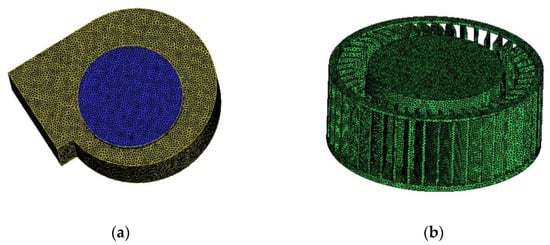
Figure 3.
Centrifugal fan fluid domain mesh model. (a) Volute mesh model. (b) Impeller grid model.
Considering the mesh and the number of nodes in the fluid domain of the centrifugal fan will directly affect the calculation efficiency. If a small grid is selected, the number of grids will increase; although the calculation results are more accurate, the calculation efficiency cannot be guaranteed. However, if a large grid is selected, the number of grids will decrease; although the calculation efficiency is higher, it cannot accurately describe the information about the flow field of the fan, and the accuracy of the calculation results cannot be guaranteed. Therefore, the central role of grid-independent analysis is to choose the appropriate number of grids to calculate the aerodynamic performance of centrifugal fans. Figure 4 shows the grid-independent analysis.
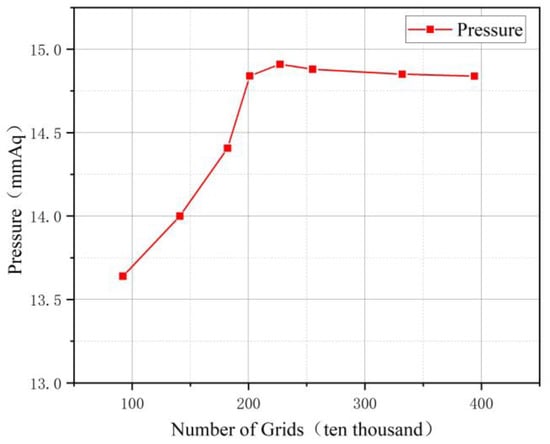
Figure 4.
Grid irrelevance analysis.
Figure 4 shows that when the number of grids reaches approximately 2.01 million, the magnitude of changes in the calculation results also stabilizes with the number of grids. This number of grids ensures the accuracy of the calculation results while improving the calculation efficiency.
In addition, in order to verify the validity of the numerical simulation, the numerical simulation results are compared with the P-Q diagram provided by the manufacturer, as shown in Figure 5.
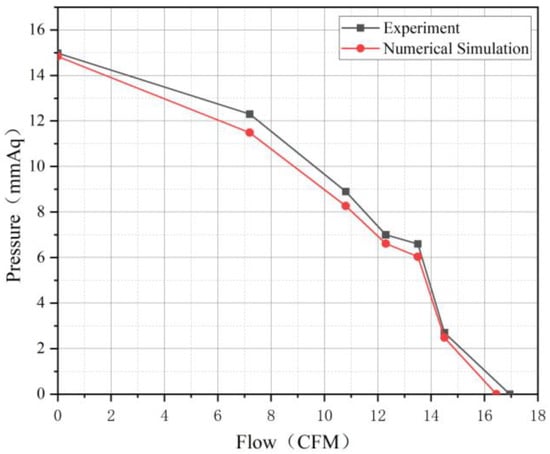
Figure 5.
Performance curve comparison.
From the figure, it can be seen that the error between the simulation results and the experimental results is small, which is within 8%, and the trend of the P-Q performance curves of the simulation results and the experimental results is consistent. In summary, the validity of the numerical simulation is verified.
3. Influence of Impeller Structure Parameters on the Aerodynamic Performance of the Centrifugal Fan
3.1. Influence of Blade Number on the Aerodynamic Performance of the Centrifugal Fan
As an important structural parameter of the impeller, the number of blades plays an essential role in the aerodynamic performance of the fan. If the number of blades is too high, the space available for gas movement in the impeller channel will be reduced, which is prone to clogging; if the number of blades is too low, the space available for gas movement in the impeller channel will increase, which will lead to an increase in the diffusion loss [25]. Therefore, this section selects 44, 46, 48, 50, 52, and 54, six kinds of blade numbers, to explore the impact of the number of blades on the performance of centrifugal fans. Figure 6 shows the variation in fan performance parameters with the number of blades.
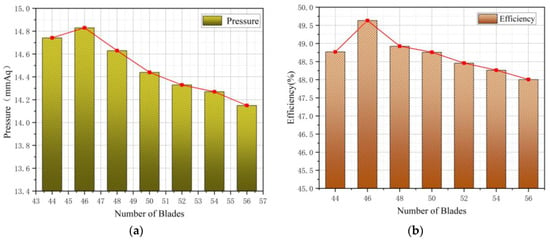
Figure 6.
Variation in centrifugal fan performance parameters with the number of blades. (a) Fan pressure varies with the number of blades. (b) The efficiency of the fan varies with the number of blades.
The aerodynamic performance of the fan is not positively correlated with the number of blades, and in the number of blades selected above, the pressure and efficiency show a pattern of first increasing and then decreasing. When the number of blades is 54, fan aerodynamic performance is poor; pressure and efficiency in the selected number of blades have the lowest values, with an efficiency of about 48.2% and a pressure of approximately 14.27 mmAq (mm water column). When the number of blades is 46, the selected number of blades for the optimal solution has the best aerodynamic performance, pressure, and efficiency of the highest value; efficiency is about 49.61%, and pressure is approximately 14.83 mmAq. The object of study in this paper is a micro-small centrifugal fan, which has a smaller structural size, and thus a smaller area of flow turbulence, so that the peaks of pressure and efficiency are shown as being on the same number of blades in the figure.
3.2. Influence of Inlet and Outlet Angle of the Blade on the Aerodynamic Performance of the Centrifugal Fan
The impeller structure of the fan described herein adopts a single circular-arc blade, and Figure 7 shows a schematic diagram of the single circular-arc blade structure.
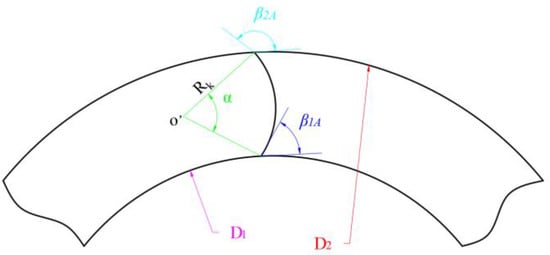
Figure 7.
Schematic diagram of single circular-arc blade structure.
As can be seen from Figure 7, the equation of the geometric relationship of the single circular-arc blade can be derived from the geometric relationship between the centroid angle α, arc radius Rk, blade inlet and outlet angles β1A and β2A, and the inner and outer diameters of the impeller D1 and D2, as shown in the following equation:
where R1 and R2 are the inner and outer radii of the impeller, respectively; Roo′ is the distance from the center of the blade circle, O′, to the center O of the impeller.
From the above equation, it can be seen that the shape of the blades can be adjusted by changing the inlet and outlet angles of the blades in the case of constant inner and outer radii of the impeller. Therefore, the main content of the study in this section is to investigate the effect of the combination of blade inlet and outlet angles on the aerodynamic performance of the fan. In this section, the angles of β1A are selected as 65°, 70°, 75°, 80°, and 85°, and the angles of β2A are selected as 112°, 116°, 120°, 124°, and 128°. The blade shapes of 25 different angle combinations are established by SolidWorks software, and numerical simulation calculations are carried out. In order to visually demonstrate the influence of various angle parameter combinations on the fan’s aerodynamic performance, a line graph will be generated from the numerical simulation results to depict the changes in its performance parameters effectively. Figure 8 shows the pressure with the blade inlet and outlet and the mouth angle change diagram.
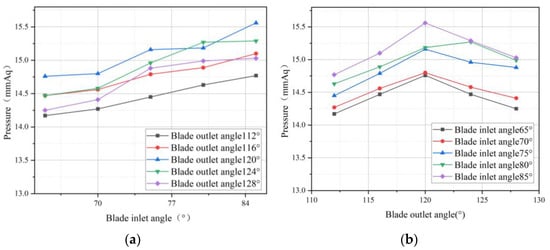
Figure 8.
Pressure variation with blade inlet and outlet angles. (a) Pressure varies with the blade inlet angle. (b) Pressure varies with the blade outlet angle.
From Figure 8, it can be seen that in the selected combination of angular parameters, the pressure is positively correlated with the blade inlet angle β1A and has a tendency first to increase and then decrease with the blade outlet angle β2A. When β1A = 85° and β2A = 120°, the fan pressure is the largest, and its value is about 15.56 mmAq; when β1A = 65° and β2A = 112°, the fan pressure is the lowest, and its value is approximately 14.17 mmAq. The highest pressure is achieved when β2A = 120°, and β1A is its blade shape combination, with the exception of β1A = 80°. The aerodynamic performance reaches its optimum value when β2A = 124°. In addition, the fan pressure is greatly affected by β2A, so if it is necessary to increase the fan outlet pressure, the adjustment of the blade outlet angle can be prioritized.
The efficiency of the fan is further analyzed, and Figure 9 shows the variation in efficiency with blade inlet and outlet angles.
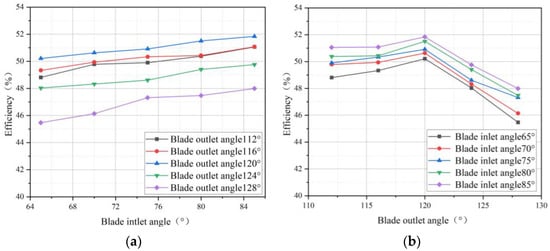
Figure 9.
Variation in efficiency with blade inlet and outlet angles. (a) Efficiency varies with the blade inlet angle. (b) Efficiency varies with the blade outlet angle.
As can be seen from Figure 9, the fan efficiency is positively correlated with the inlet angle β1A, while it tends first to increase and then decrease with the outlet angle β2A. In the above angular parameter combinations, when β1A = 85° and β2A = 120°, the fan work efficiency is the highest, and its value is about 51.84%; when β1A = 65° and β2A = 128°, the fan work efficiency is the lowest, and its value is approximately 45.47%. In each angular parameter combination of β1A and β2A, their peak efficiency values all appeared when β2A was 120°. In addition, it is not difficult to find that when β2A increases from 120° to 128°, the efficiency of the fan begins to decrease, which is mainly due to the gradual increase in the degree of contraction of the impeller channel and the increase in the curvature of the blades, which results in an increase vortex, friction, and other losses in the impeller channel. Among the combinations of blade angle parameters, the angle parameter combination of β2A = 128° has the lowest efficiency.
3.3. Influence of Blade Thickness and Height on the Aerodynamic Performance of the Centrifugal Fan
Under the condition that the blade inlet and outlet angles and blade chord length remain constant, the combination of blade thickness and height determines the windward area of the fan blade. The larger the windward area, the stronger the load-carrying capacity and the greater the flow and pressure of the fan, but this will also lead to an increase in torque, thus reducing the efficiency of the possibility. For this reason, this section mainly analyzes the impact of fan blade thickness and height on the aerodynamic performance of the fan. Figure 10 shows a schematic diagram of the blade thickness and height structure.
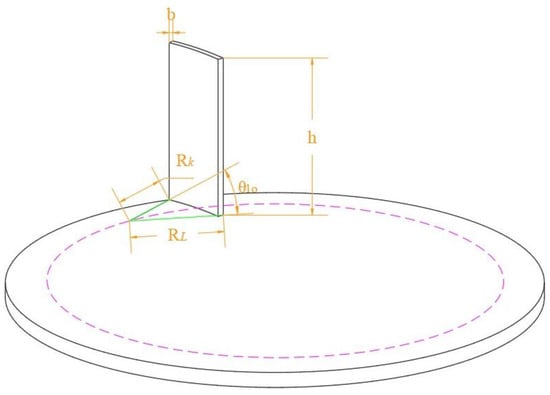
Figure 10.
Schematic diagram of single blade thickness and height structure.
As can be seen from Figure 10, the geometric relationship between the blade windward area S and the blade height h and thickness b can be deduced from the geometric relationship shown in the following equation:
where S is the windward area of a single blade; Rk is the distance between the center of the blade circle and the working surface of the blade; RL is the distance between the center of the blade circle and the non-working surface of the blade; θ1o is the angle between Rk and RL.
In this section, the selected blade heights are 15, 17, 19, 21, and 23 mm; the blade thicknesses are 0.6, 0.8, 1.0, 1.2, and 1.4 mm. A total of 25 different combinations of structures are established and numerically simulated by SolidWorks software. To intuitively reflect the impact of different combinations of structural parameters on the aerodynamic performance of the fan, a line graph will be generated from the numerical simulation results to effectively depict the changes in its performance parameters, which will better reflect the change in its performance parameters. Figure 11 and Figure 12 show the pressure and efficiency with the blade height and thickness change diagram.
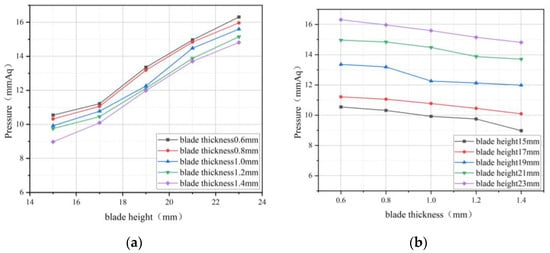
Figure 11.
Pressure variation with inlet blade height and thickness. (a) Pressure varies with blade height. (b) Pressure varies with blade thickness.
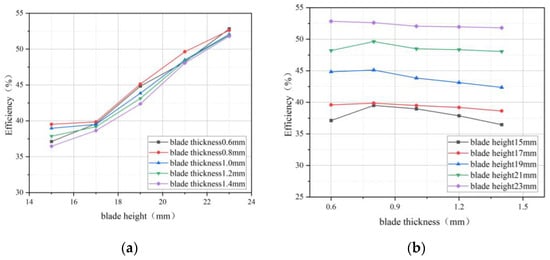
Figure 12.
Variation in efficiency with inlet blade height and thickness. (a) Efficiency varies with blade height. (b) Efficiency varies with blade thickness.
From Figure 11, it can be seen that in the above combination of structural parameters, when h = 23 mm and b = 0.6 mm, the fan pressure is the largest, and its value is about 16.31 mmAq; when h = 15 mm and b = 1.4 mm, the fan pressure is the smallest, and its value is about 8.98 mmAq. Pressure increases with the increase in the height of the blades, which has a positive correlation, and pressure decreases with the increase in the thickness of the blades, which has a negative correlation.
From Figure 12, it can be seen that among the above combinations of structural parameters, the fan efficiency is the largest when h = 23 mm and b = 0.6 mm, and its value is about 52.83%; when h = 15 mm and b = 1.4 mm, the fan efficiency is the smallest, and its value is approximately 36.46%. In addition, the synthesis of Figure 13 and Figure 14 shows that, compared to the blade thickness, the blade height has a more significant impact on the performance of the fan.
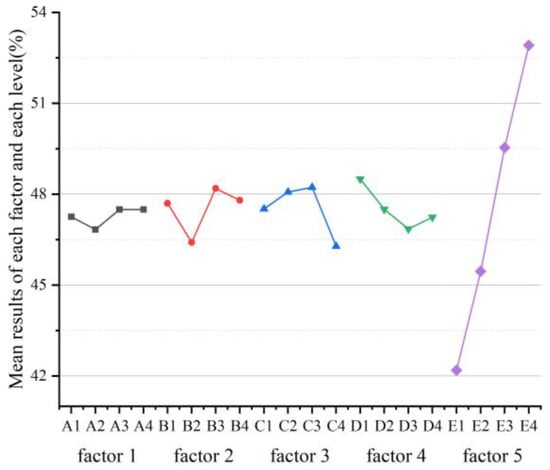
Figure 13.
Orthogonal test visual analysis result diagram.
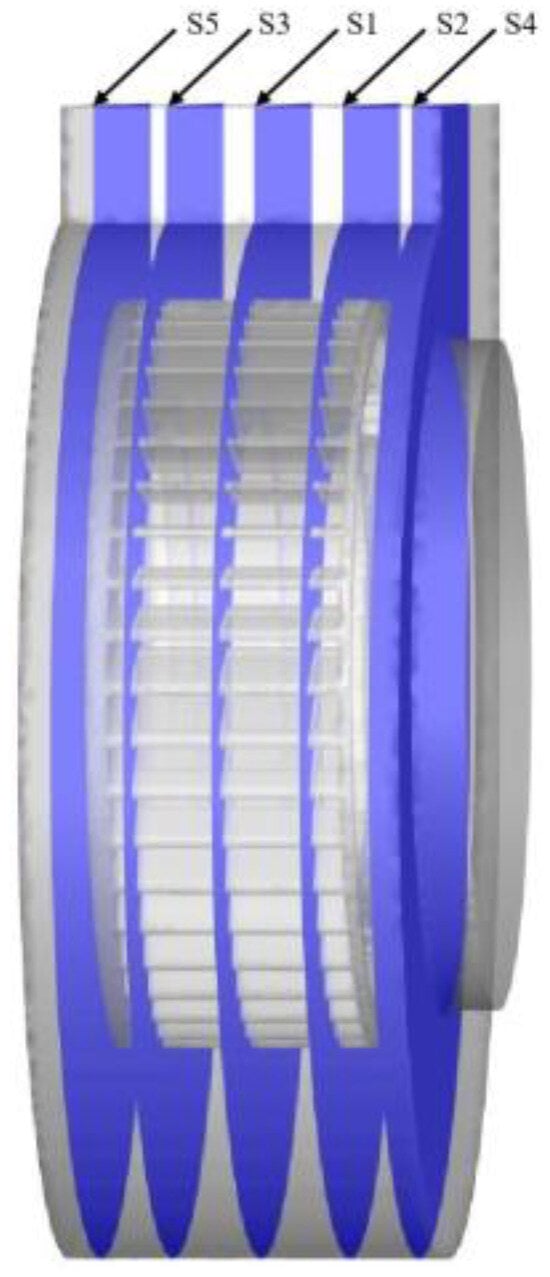
Figure 14.
Schematic cross-section of prototype flow field analysis.
In summary, with the increase in the thickness of the fan blade, the gas movement space in the impeller channel becomes narrow, quickly leading to the emergence of the gas blockage phenomenon, making the fan inefficient. If the thickness of the blade is too thin, it is difficult to manufacture and process, and it is easy to cause fatigue fractures of the blade. With the reduction in blade height, the windward area of the blade is reduced, and the kinetic energy of the gas and the pressure energy can be significantly reduced, leading to a decrease in the aerodynamic performance indicators of the fan. With the increase in the height of the blade, the windward area increases, the gas gets more energy, and thus the pressure has been significantly improved, but due to the top of the blade and the volute gap reduction, the gas and the friction of the solid boundary loss will also be increased. From Figure 11 and Figure 12, the blade height and fan aerodynamic performance show a monotonically increasing trend. The main reason for this is that the miniature centrifugal fan chosen for this paper has relatively small friction losses due to size constraints. In addition, increasing the windward area can effectively improve the pressure, but the torque is positively correlated with the windward area, so there is a possibility of making the fan efficiency decline. There is a positive correlation between windward area and fan efficiency for the parameter combinations selected in this paper.
4. Impeller Structure Parameter Optimization
4.1. Orthogonal Test
Orthogonal tests are mathematical and statistical methods for solving multifactorial and multi-level problems. Orthogonal test protocols have two main characteristics, i.e., being evenly dispersed and neatly comparable [26]. Uniform dispersion means that the experimental protocol is representative, and neat comparability implies that the data can be easily analyzed and processed. The orthogonal test has the advantages of high efficiency and economy, and it can obtain the optimal combination of parameters within a limited number of experiments. The orthogonal test has three concepts: factor, level, and test index. There are two methods of analyzing orthogonal tests, namely, intuitive analysis and analysis of variance [27]. In this paper, the intuitive analysis method, also known as the analysis of range analysis, is selected. Its steps are shown as follows:
- (1)
- Sum the levels of each factor of the test index and take the average to obtain Kij:
- (2)
- Solve for the extreme deviation, i.e., the difference between the maximum mean and the minimum mean at each level, using R1 as an example:
The extreme variance of each factor satisfies
Based on Ri, to consider the degree of influence of each factor level on the test index, the larger the extreme difference, the more influential the numerical change of the test index and the more pronounced the impact on the test results.
Based on the above research in this chapter, to select the optimal parameter combination of the impeller structure, this section takes the number of blades, blade inlet and outlet angles, blade height, and blade thickness together into five factors, and four levels are selected for each factor, namely:
- (1)
- Factor A: number of blades Z = 44, 46, 48, 50;
- (2)
- Factor B: blade inlet angle β1A = 70°, 75°, 80°, 85°;
- (3)
- Factor C: blade outlet angle β2A = 112°, 116°, 120°, 124°;
- (4)
- Factor D: blade thickness b = 0.6 mm, 0.8 mm, 1.0 mm, 1.2 mm;
- (5)
- Factor E: blade height h = 17 mm, 19 mm, 21 mm, 23 mm.
In summary, the orthogonal test program table with five factors and four levels, L16(45), was selected. In addition, according to the formula for fan efficiency [28], it can be seen that because the torque of the micro-small centrifugal fan does not change much, the fan efficiency can be used to reflect the aerodynamic performance of the fan, and therefore the efficiency is used as the test index, which is subordinate to the single-indicator orthogonal test. The results are analyzed as shown in Table 2.

Table 2.
Table analyzing the results of the L16(45) orthogonal test.
4.2. Analysis of Numerical Simulation Results
To further compare the difference between the internal flow field of the prototype and the optimized prototype, this paper analyzes the gas flow inside the fan by establishing five cross-sections, as shown in Figure 14, namely, S1, S2, S3, S4, and S5. S1 cross-section is the high plane of the 1/2 impeller, S2 is the high plane of the 3/4 impeller, S3 is the high plane of the 1/4 impeller, S4 is the 1/2 spacing between the bottom of the impeller chassis and the bottom of the volute, and S5 is the 1/2 spacing between the top of the impeller and the top of the volute, 1/2 pitch of the top of the volute.
To reflect the flow field of the optimized prototype and the prototype, this paper uses Tecplot 2022 R1 software to visualize the flow field of the numerical simulation results, and Figure 15 and Figure 16 show the pressure and velocity distributions of each cross-section.
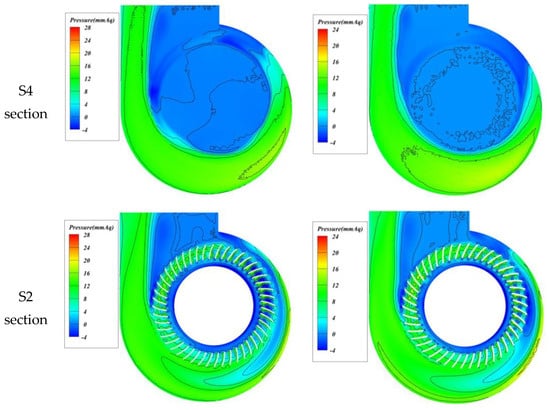
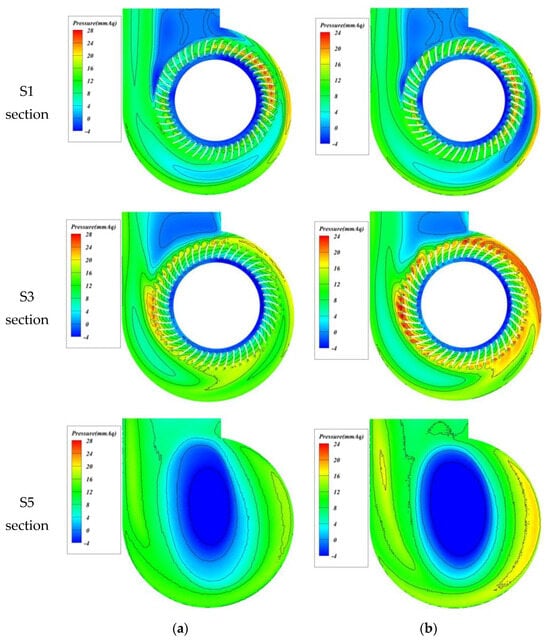
Figure 15.
Pressure distribution cloud of each cross-section. (a) Optimized prototype. (b) Prototype.
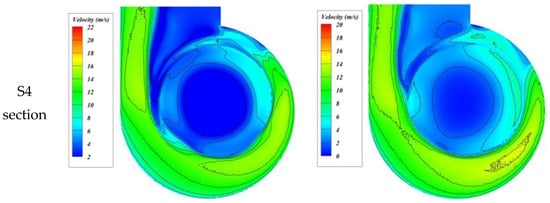
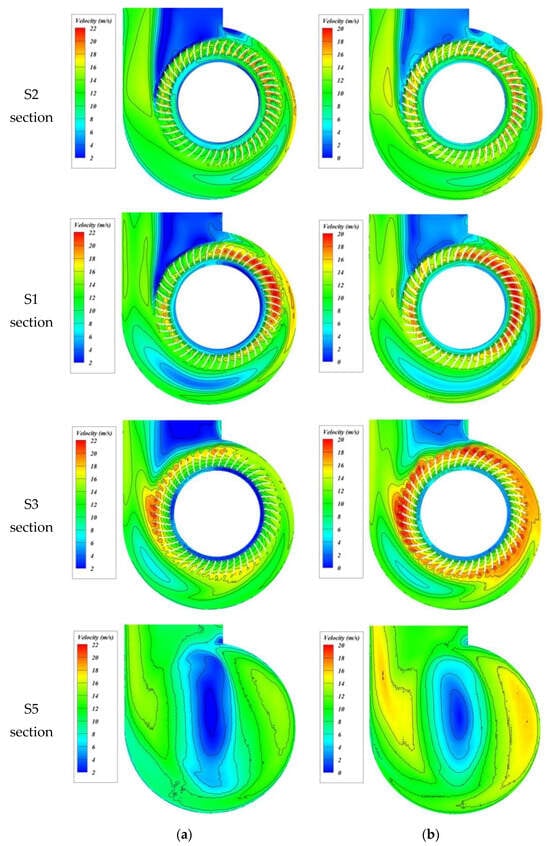
Figure 16.
Velocity distribution cloud of each cross-section. (a) Optimized prototype. (b) Prototype.
As can be seen in Figure 15, from the perspective of outlet pressure distortion, it can be found that the optimized prototype is less severe than the prototype. In addition, overall, the pressure distribution of the optimized prototype is more uniform in each cross-section. The area of the low-pressure zone in the static domain is smaller, and the phenomena of both airflow blockage and diffusion loss in the dynamic domain have been weakened to a certain extent.
From Figure 16, it can be seen that under the optimized impeller structure parameters, the overall velocity of the airflow is faster than that of the prototype, which is mainly due to the increase in the windward area of the impeller, so that the carrying capacity of the blade is significantly increased. In addition, the optimized prototype has better internal flow field uniformity, less outlet velocity distortion phenomenon, and the area of the low-speed zone in the static domain is smaller. From the dynamic domain, it can be found that the “jet-wake” phenomenon at the trailing edge of the blade is lighter.
Standard criteria for vortices include the pressure criterion method, helicity method, Q Criterion, λ2 Criterion, and Ω Criterion. The different vortex structures reflect the flow characteristics of the fluid in the computational domain. The Q Criterion is considered to provide critical physical insights for understanding the internal flow laws and localized flow losses in the flow field [29]. Its calculation formula is as follows:
where Q is the quadratic invariant of the velocity gradient tensor, Sij is the strain rate tensor, and Ωij is the vortex tensor.
Considering that for the identification and visualization of vortex features so that the minimum pressure appears on the core of the vortex, the Q Criterion Normalized is applied in post-processing [30]. The Q Criterion Normalized is shown in the following equation:
Based on this equation, it is known that the Q Criterion Normalized has a value between −1 and 1, and the best value in this range is chosen to identify the vortices in the flow field and is the dimensionless Q Criterion. Figure 17 shows the 3D vortex plots of the prototype and optimized prototype.
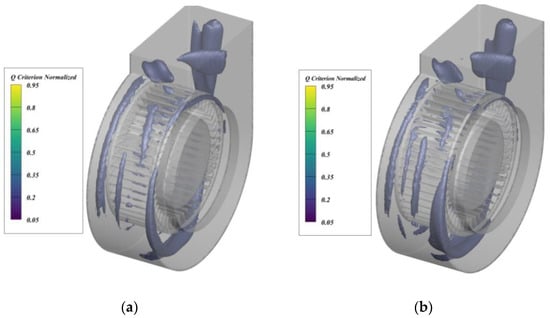
Figure 17.
Three-dimensional vortex diagram of the prototype and optimized prototype. (a) Vorticity of the prototype. (b) Optimization of the vorticity of the prototype.
From the figure, it can be seen that the optimized prototype’s scroll size, number of scrolls, and scroll strength are lower than those of the prototype. In summary, the aerodynamic performance of the fan optimized with impeller structure parameters is better than that of the prototype.
5. Experimental Verification
5.1. Experimental Platform Construction
We created an optimized prototype using 3D printing technology and built an experimental analysis platform. The empirical analysis platform consists of three main components: a fan system, a power supply system, and a measurement system. Because the micro-small centrifugal fan is very susceptible to the influence of external environmental factors and is limited by the experimental conditions, drawing on the relevant experiments of the micro-small centrifugal fan made by Zhang Nanzhen of Nanjing University of Aeronautics and Astronautics, a kind of enclosed space similar to a wind tunnel is designed, as shown in Figure 18, and the fan is put into the interior, which is mainly designed to minimize the influence of environmental factors on the experimental results of the fan’s aerodynamic performance.
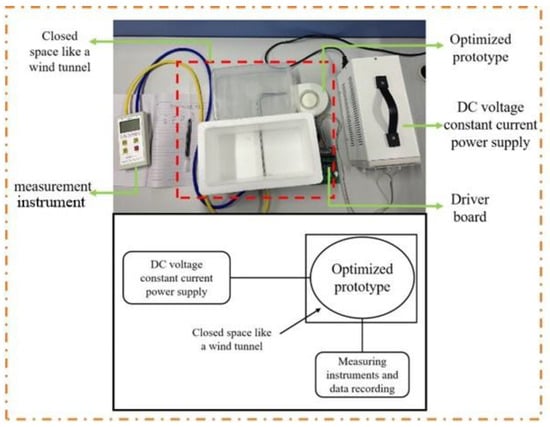
Figure 18.
Experimental simulation platform.
5.2. Experimental Method Design
The primary purpose of this experiment is to verify the validity of numerical simulation. This experiment will select a total of 18 measurement points in the cross-section of S1, S2, and S3 using the chosen digital micro-pressure differential meter to measure the airflow, as shown in Figure 19.
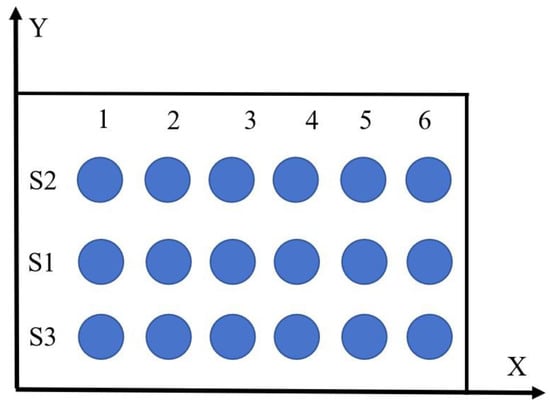
Figure 19.
Fan outlet cross-section measurement points.
As this paper is based on the Reynolds time-averaged simulation method (RANS) to carry out the numerical simulation, RANS ignores the influence of the time term, so the calculation results are time-averaged flow fields. Therefore, it is necessary to wait for the fan speed to stabilize and then measure it to ensure the reliability of the experimental data. After obtaining the measurement data for 18 measurement points, we carried out the averaging process and compared the value with the simulation results to ensure the effectiveness of the numerical simulation and the accuracy of the data obtained in this paper. In addition, the outlet velocity can also be verified based on the outlet velocity of each cross-section to verify the outlet velocity aberration obtained from the numerical simulation, which provides the experimental research basis for the subsequent directional optimization of the volute.
5.3. Analysis of Experimental Results
The experimental data of optimized fan airspeed is shown in Table 3.

Table 3.
Optimized fan wind speed experimental data (m/s).
Table 3 shows that the experiment adopted the multi-point measurement method to sample and measure the wind speed of the optimized prototype. After sampling, it is necessary to sum up the measured values and then take the average value, and it can be seen that the wind speed of the fan outlet is about 4.3 m/s. Through the conversion, it can be seen that the optimized prototype’s flow rate is approximately 19.60 CFM, which is about 9.03% different from that of the numerical simulation results.
Compared with the simulation results, the flow rate of the fan measured according to the experiment is small, which is caused by the limitation of the experimental equipment, the airtightness problem of the constructed wind tunnel space, as well as the upper and lower worm housings being connected by threads, which are prone to air leakage when the fan is working. In addition, there are also further reasons, such as numerical-simulation-related settings, which include mesh quality, quantity, turbulence model selection, and other influencing factors. However, the difference between the numerical simulation results and the experimental results is less than 10%, which can verify the truth and validity of the numerical simulation results.
6. Conclusions
In this paper, the effects of five parameters, namely, number of blades, blade inlet angle, blade outlet angle, blade height, and blade thickness, on the aerodynamic performance of the fan are investigated using a combination of numerical simulation and experimental validation, and the following conclusions are drawn:
- (1)
- The effects of five structural parameters, namely, blade number, blade inlet angle, blade outlet angle, blade height, and blade thickness, on the aerodynamic performance of centrifugal fans were analyzed. From the analysis of the orthogonal test results, it can be seen that the influence of the five parameters is in the order of blade height > blade outlet angle > blade inlet angle > blade number > blade thickness. We established the optimal combination of impeller structure parameters, that is, the number of blades is 48, the blade inlet angle is 80°, the blade outlet angle is 120°, the blade height is 23 mm, and the blade thickness is 0.6 mm.
- (2)
- The centrifugal fan with the optimal combination of impeller parameters was remodeled using SolidWorks, and the parameters related to the aerodynamic performance of the centrifugal fan were obtained through numerical simulation. The optimized prototype increases the pressure by about 10% and the air volume by about 31% compared to the prototype. A test platform was built to verify the effectiveness of the numerical simulation, which ensures the applicability of the orthogonal test in the structural optimization of centrifugal fan impellers and provides a reference for the design and optimization of centrifugal fans.
- (3)
- The pressure and flow velocity distribution of the optimized prototype and the prototype flow field were analyzed, and it was found that the outlet velocity distortion and “jet-wake” phenomenon of the optimized prototype have been improved, the homogeneity of the flow field has improved, and the aerodynamic performance of the fan has been upgraded. Based on the Q Criterion Normalized comparison of the three-dimensional vortices inside the optimized prototype and the prototype, the vortex scale and size of the optimized prototype are better than those of the prototype, which is also the reason for the improvement of the aerodynamic performance of the optimized prototype.
Author Contributions
Conceptualization, X.Z. and J.G.; methodology, X.Z. and J.G.; software, J.G.; validation, X.Z., T.W., X.L. and J.G.; formal analysis, Q.X. and J.G.; investigation, J.G. and J.Z.; resources, X.Z.; data curation, J.G.; writing—original draft preparation, J.G.; writing—review and editing, J.G.; visualization, J.G.; supervision, X.Z.; project administration, X.Z.; funding acquisition, X.Z. All authors have read and agreed to the published version of the manuscript.
Funding
This research was funded by the Heilongjiang Natural Science Fund (No. E201020).
Data Availability Statement
Data are contained within the article.
Acknowledgments
This project was supported by the Heilongjiang Natural Science Fund (No. E201020).
Conflicts of Interest
The authors declare no conflicts of interest.
References
- Zhao, X.T.; Guan, J.H.; Liu, X.Y. Review of research on respiratory protective equipment in the medical field in the post-epidemic era. China Pers. Prot. Equip. 2023, 3, 32–38. [Google Scholar]
- Chen, X.; Gong, Y.; Chen, X.B.; Zhang, X.; Wang, G.; Liao, Y.Y.; Liu, D.J. Optimization of centrifugal fan performance based on FLUENT. Jiangsu Agric. Sci. 2019, 47, 250–254. [Google Scholar]
- Zhang, H.; Wen, J.; Zhan, J.; Xin, D. Effects of blade number on the aerodynamic performance and wake characteristics of a small horizontal-axis wind turbine. Energy Convers. Manag. 2022, 273, 116410. [Google Scholar] [CrossRef]
- Wen, J.; Zhou, L.; Zhang, H. Mode interpretation of blade number effects on wake dynamics of small-scale horizontal axis wind turbine. Energy 2023, 263, 125692. [Google Scholar] [CrossRef]
- Ding, H.; Chang, T.; Lin, F. The Influence of the Blade Outlet Angle on the Flow Field and Pressure Pulsation in a Centrifugal Fan. Processes 2020, 8, 1422. [Google Scholar] [CrossRef]
- Tantakittl, P.; Pattana, S.; Wiratkasem, K. The Performance of Backward Curved Centrifugal Fan with Various Impeller Inlet and Outlet Angles. In Proceedings of the 2018 Third International Conference on Engineering Science and Innovative Technology (ESIT), North Bangkok, Thailand, 19–22 April 2018; pp. 1–3. [Google Scholar]
- Wu, Y.; Dou, S.H.; Wei, K.Y.; Chen, X.P.; Chen, Y.N.; Cao, W.B. Effect of Attack Angle on Flow Characteristic of Centrifugal Fan. IOP Conf. Ser. Mater. Sci. Eng. 2016, 129, 012059. [Google Scholar] [CrossRef]
- Lei, J.; Jia, C.; Cui, Q.; Cheng, W.; Qin, G. Cause Analysis and Suppression Method of the Vortex at the Impeller Outlet of the Multiblade Centrifugal Fan. Energy Sci. Eng. 2023, 11, 3364–3378. [Google Scholar] [CrossRef]
- Lin, S.-C.; Huang, C.-L. An Integrated Experimental and Numerical Study of Forward–Curved Centrifugal Fan. Exp. Therm. Fluid Sci. 2002, 26, 421–434. [Google Scholar] [CrossRef]
- Wei, Y.; Ying, C.; Xu, J.; Cao, W.; Wang, Z.; Zhu, Z. Effects of Single-Arc Blade Profile Length on the Performance of a Forward Multiblade Fan. Processes 2019, 7, 629. [Google Scholar] [CrossRef]
- Zhao, X.; Guan, J. Influence of the Spatial Position of the Semi-Open Impeller on the Internal Flow Field in Centrifugal Fans. J. Phys. Conf. Ser. 2023, 2574, 012007. [Google Scholar] [CrossRef]
- Kim, K.Y.; Seo, S.J. Application of numerical optimization technique to design of forward-curved blades centrifugal fan. JSME Int. J. Ser. B Fluids Therm. Eng. 2006, 49, 152–158. [Google Scholar] [CrossRef][Green Version]
- Ottesten, M.; Yao, H.D.; Davidson, L. Inlet Gap Effect on Aerodynamics and Tonal Noise Generation of a Voluteless Centrifugal Fan. J. Sound Vib. 2022, 540, 117304. [Google Scholar] [CrossRef]
- Prezelj, J.; Novaković, T. Centrifugal Fan with Inclined Blades for Vacuum Cleaner Motor. Appl. Acoust. 2018, 140, 13–23. [Google Scholar] [CrossRef]
- Alinejad, J.; Montazerin, N.; Samarbakhsh, S. Accretion of the Efficiency of a Forward-Curved Centrifugal Fan by Modification of the Rotor Geometry: Computational and Experimental Study. Int. J. Fluid Mech. Res. 2013, 40, 469–481. [Google Scholar] [CrossRef]
- Wang, Y.; Dong, Q.L.; Zhang, Y.L. Meridional shape design and the internal flow investigation of centrifugal impeller. Proc. Inst. Mech. Eng. Part C J. Mech. Eng. Sci. 2017, 231, 4319–4330. [Google Scholar] [CrossRef]
- Qi, G.W.; Wei, Z. Noise reduction mechanisms for the inclined leading edge vaned diffuser in a centrifugal fan. Proc. Inst. Mech. Eng. Part A J. Power Energy 2017, 231, 68–83. [Google Scholar] [CrossRef]
- Zhou, B.; He, X.; Yang, H.; Zhu, Z.; Wei, Y.; Zhang, Y. Unsteady Flow Characteristics of Rotating Stall and Surging in a Backward Centrifugal Fan at Low Flow-Rate Conditions. Processes 2020, 8, 872. [Google Scholar] [CrossRef]
- Yan, R. Research on the Influence of Ventilator Structure on the Characteristics of Flow Field as well as Performance. Master’s Thesis, Shandong University, Jinan, China, 2022. [Google Scholar]
- Shih, T.; Liou, W.; Shabbir, A.; Yang, Z.; Zhu, J. A new k-ε eddy viscosity model for high Reynolds number turbulent flows. Comput. Fluids 1995, 24, 227–238. [Google Scholar] [CrossRef]
- Bai, C. Study on Flow Field in Respiratory Cavity of Dynamic Air Supply Respiratory Protection Device. Master’s Thesis, Harbin University of Science and Technology, Harbin, China, 2023. [Google Scholar]
- Newton, W.; Lewis, M.; Carswelld, D.; Lavery, N.P.; Evans, B.; Bould, D.; Sienz, J. Investigating the Thermal Profile of a Marine Vessel Engine Room through Simulation with Field Measurements. Appl. Therm. Eng. 2014, 73, 1360–1370. [Google Scholar] [CrossRef][Green Version]
- Wang, F. Research Progress of Rotational Turbulence Computing Model for Fluid Machinery. Trans. Chin. Soc. Agric. Mach. 2016, 47, 1–14. [Google Scholar]
- Blocken, B.; Toparlar, Y. A Following Car Influences Cyclist Drag: CFD Simulations and Wind Tunnel Measurements. J. Wind. Eng. 2015, 154, 178–186. [Google Scholar] [CrossRef]
- Chen, J.; Shi, H.; Zhao, Y.; Xi, B.; Geng, D. Parameter optimization of small forward bending centrifugal fan impeller. J. Hunan Univ. (Nat. Sci. Ed.) 2022, 49, 75–82. [Google Scholar]
- Huang, X.; Kang, N.; Coddet, P.; Mansori, M.E. Analyses of the Sliding Wear Behavior of NiTi Shape Memory Alloys Fabricated by Laser Powder Bed Fusion Based on Orthogonal Experiments. Wear 2023, 534–535, 205130. [Google Scholar] [CrossRef]
- Liang, Y.Z.; Yuan, K.Z.; Chao, Z.Z. Optimal Design of Impeller for Self-Priming Pump Based on Orthogonal Method. Sci. Rep. 2023, 13, 16491. [Google Scholar]
- Heo, M.-W.; Kim, J.-H.; Seo, T.-W.; Kim, K.-Y. Aerodynamic and aeroacoustic optimization for design of a forward-curved blades centrifugal fan. Proc. Inst. Mech. Eng. Part A J. Power Energy 2016, 230, 154–174. [Google Scholar] [CrossRef]
- Chen, Y. Study on Aerodynamic Performance Optimization and Internal Flow Characteristics of High-Speed Centrifugal Fan for Vacuum Cleaner. Master’s Thesis, Zhejiang University of Science and Technology, Hangzhou, China, 2023. [Google Scholar]
- Ren, X.; Guo, Y.; Shen, S.; Zhang, K. Large Eddy Simulation of Flow Field in Thermal Vapor Compressor. Front. Energy Res. 2022, 10, 1008927. [Google Scholar] [CrossRef]
Disclaimer/Publisher’s Note: The statements, opinions and data contained in all publications are solely those of the individual author(s) and contributor(s) and not of MDPI and/or the editor(s). MDPI and/or the editor(s) disclaim responsibility for any injury to people or property resulting from any ideas, methods, instructions or products referred to in the content. |
© 2024 by the authors. Licensee MDPI, Basel, Switzerland. This article is an open access article distributed under the terms and conditions of the Creative Commons Attribution (CC BY) license (https://creativecommons.org/licenses/by/4.0/).